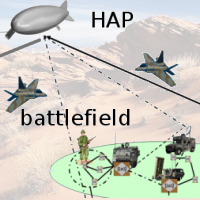Cognitive Routing for Tactical Ad Hoc Networks
Military and crisis management networks are characterised by their ad-hoc heterogeneous structure. For example, they will contain low-capability sensors, medium-capability nodes for speech/video delivery, or even high-capability 'landmark' nodes with directional antennas which will relay trunked traffic directly to headquarters. This project seeks to improve their scalability, reducing the impact of the node relaying overhead through improved network management and better coordination of the routing, bandwidth assignment, and physical layer transmission methodologies. The ultimate goal is to increase the viable network size by an order of magnitude.
The project will bring together the following interrelated aspects:
- System level topology design and connectivity - exploitation of principles used in trunked networks to minimise the impact of relaying. The project will also investigate how high altitude platforms (and other forms of UAV) can reduce routing overheads and increase system capabilities.
- Cognitive routing - development of novel routing metrics to reduce the impact of relaying and minimise spectral impact. These will incorporate parameters originating from the other protocol layers, such as "disturbance", "scalability", "link capacity" and node specific capabilities, to intelligently select optimum routes through the network. Asymmetric routing strategies that exploit multicast transmissions will be studied to further reduce overheads.
- Cognitive bandwidth assignment - use of cognitive radio techniques in a shared (and potentially hostile) spectrum environment to assign capacity to individual links. The impact of antenna directionality to reduce the impact of interference on the system will be examined, where nodes will operate with a range of modulation and coding formats, e.g. OFDM and Direct Sequence Spread Spectrum. Use of different intelligence and learning strategies will be explored, including game theory.
- Supernodes - use of co-operative diversity to form high capability 'nodes' from several low capability nodes to reduce the need to relay traffic. Beamforming and Space Time Block Codes, i.e. using the basic nodes as a virtual MIMO array, will be investigated in detail.
- Disposable nodes - to improve network connectivity and the ability to form supernodes, the project will examine the potential benefits of using 'disposable' nodes to collectively relay traffic away from a potential target, allowing transmissions to appear diffuse, thereby reducing the likelihood of malicious entities pinpointing positions.
- Intelligent agents - examination of the applicability of both reactive and cognitive agents in symmetric and asymmetric routing situations. If time permits the project will also investigate how agents can be incorporated into bandwidth assignment

Members
- David Grace
- Paul Mitchell
- Tim Clarke
- Alister Burr
- Dave Pearce
- Yiming Liu
- Andrew Pomfret
- Yu Deng
- Pairoj Likitthanasate
- Jingxin Chen
- Danshan Chen
- Yi Wang
Funding
- MOD Competition of Ideas
Dates
- October 2007 to
September 2008
Research
